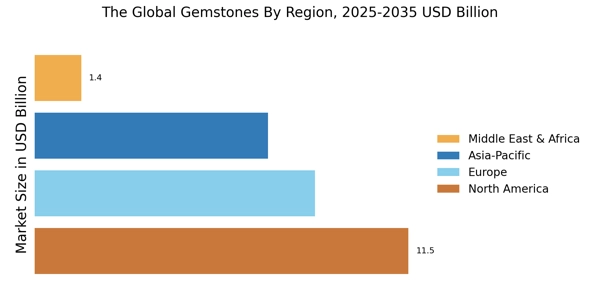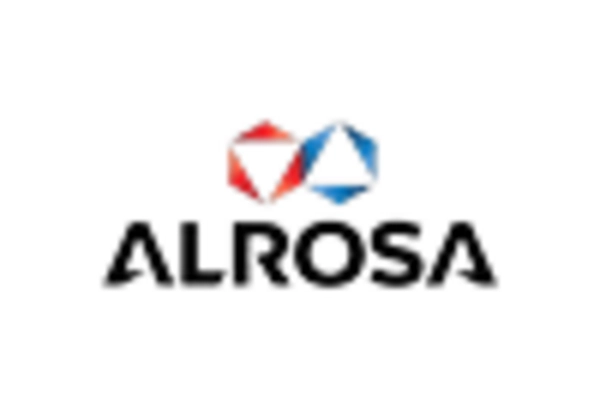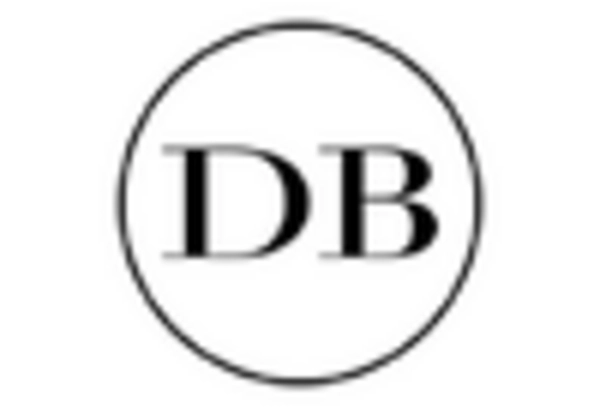Expansion of Online Retail Platforms
The expansion of online retail platforms is significantly impacting the gemstones market. E-commerce has revolutionized the way consumers purchase gemstones, providing them with access to a wider variety of products than ever before. Online platforms allow consumers to compare prices, read reviews, and access detailed product information, enhancing their purchasing experience. In 2023, online sales of gemstones accounted for approximately 25% of the total market share, reflecting a growing trend towards digital shopping. This shift is particularly pronounced among younger consumers who prefer the convenience of online shopping. As more retailers invest in their online presence, the gemstones market is likely to see continued growth driven by this digital transformation.
Rising Consumer Demand for Luxury Goods
The increasing consumer demand for luxury goods is a pivotal driver in the gemstones market. As disposable incomes rise, particularly in emerging economies, consumers are more inclined to invest in high-value items such as gemstones. This trend is evident in the growing sales of diamond jewelry, which reached approximately 80 billion USD in 2023. The allure of gemstones as symbols of status and wealth continues to attract affluent buyers, thereby propelling the market forward. Additionally, the trend towards gifting luxury items during special occasions further fuels this demand. As consumers seek unique and high-quality gemstones, the industry is likely to witness a sustained growth trajectory, driven by the desire for exclusivity and prestige.
Cultural Significance and Symbolism of Gemstones
The cultural significance and symbolism of gemstones play a crucial role in driving the gemstones market. Different cultures attribute unique meanings and values to various gemstones, influencing consumer preferences and purchasing decisions. For example, sapphires are often associated with wisdom and royalty, while emeralds symbolize rebirth and love. This cultural resonance enhances the desirability of gemstones, particularly during significant life events such as weddings and anniversaries. In many regions, gemstones are integral to traditional ceremonies, further embedding them into the cultural fabric. As consumers seek to connect with these cultural narratives, the demand for specific gemstones is likely to rise, thereby contributing to the overall growth of the market.
Technological Advancements in Gemstone Processing
Technological advancements in gemstone processing are transforming the gemstones market. Innovations such as laser cutting and 3D printing are enhancing the precision and quality of gemstone production. These technologies not only improve the aesthetic appeal of gemstones but also reduce waste and production costs. For instance, the introduction of automated grading systems has increased the efficiency of gemstone evaluation, ensuring that consumers receive high-quality products. Furthermore, advancements in synthetic gemstone production have expanded the market, offering consumers more affordable options without compromising on quality. As these technologies continue to evolve, they are expected to play a crucial role in shaping the future of the gemstones market.
Growing Interest in Sustainable and Ethical Gemstones
The growing interest in sustainable and ethical gemstones is reshaping the gemstones market. Consumers are increasingly aware of the environmental and social implications of gemstone mining. This awareness has led to a surge in demand for ethically sourced gemstones, which are perceived as more responsible choices. Reports indicate that sales of ethically sourced diamonds have increased by over 30% in recent years. Retailers are responding by offering transparency in their supply chains and promoting sustainable practices. This shift not only appeals to environmentally conscious consumers but also enhances brand loyalty. As the market adapts to these changing consumer preferences, the emphasis on sustainability is likely to become a defining characteristic of the gemstones market.


















Leave a Comment